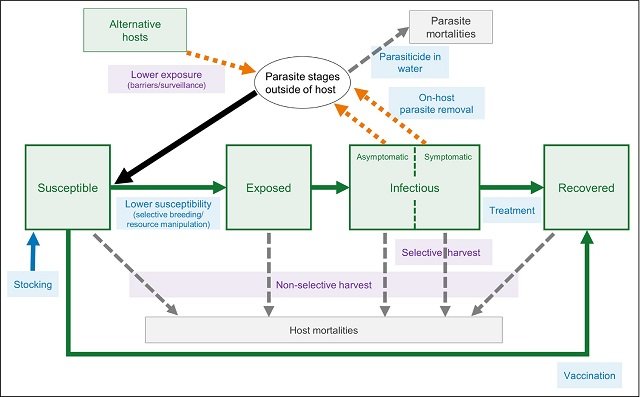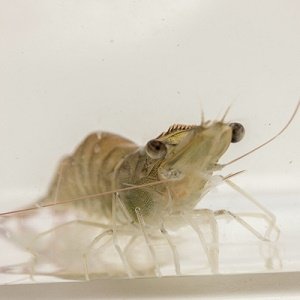
Infectious diseases pose a significant challenge to the development of the aquaculture industry, as pathogens can rapidly spread in aquatic ecosystems.
To date, disease management strategies have aimed at adjusting host density, reducing disease transmission, or improving host health. However, specific alternative actions for aquaculture systems can vary in availability and effectiveness.
To overcome these challenges, scientists from the University of Georgia, Marine Extension, and Georgia Sea Grant addressed disease management in aquaculture and fisheries production within the context of structured decision-making.
Structuring a Decision Problem
- 1 Structuring a Decision Problem
- 2 Specification of Objectives
- 3 Identifying Alternative Action Options
- 4 Modeling Approaches to Disease Management
- 5 Assessment of Disease Consequences
- 6 Uncertainty Sources About Diseases
- 7 Disease Risk Assessment
- 8 Decision Tree Proposal
- 9 Conclusion
- 10 Entradas relacionadas:
According to the researchers, “Managers implement policies and regulations to achieve stakeholders’ objectives or agency mandates. In doing so, they act as decision-makers who likely depend on imperfect information and encounter constraints that limit what can be achieved.”
Thus, a decision-making process can proceed to specify objectives and assess the expected performance of alternative management options, considering relevant information gaps.
Specification of Objectives
In the case of fishing and aquaculture, objectives often relate to catch or production, including maximizing performance or minimizing performance variability (or associated economics) over time.
The study authors report that a key feature of decision objectives is that they are based on values. They cite as an example a fundamental objective of “providing safe and sustainable seafood,” reflecting values on human safety, temporal variability in harvests, population viability, and marketability of products.
Stay Always Informed
Join our communities to instantly receive the most important news, reports, and analysis from the aquaculture industry.
Identifying Alternative Action Options
The study presents a broad classification of general strategies for disease management or mitigation, where you can identify more specific alternative actions that could be evaluated based on their potential to produce benefits.
Researchers include actions such as density manipulation, altering system connectivity, habitat modification, direct treatment, and biological intervention. Each of these actions has a series of examples that you can review in the document.
Modeling Approaches to Disease Management
Models are used to predict the consequences of management alternatives. In this context, mathematical models that capture population dynamics and parasite transmission dynamics can improve understanding of epidemiological processes.
“A collaborative modeling effort can further help foster a common understanding among participants and reveal assumptions that would otherwise be hidden,” the scientists emphasized.
Assessment of Disease Consequences
The study highlights that possible outcomes of decisions can be assessed using performance metrics associated with each measurable objective.
“Particularly, expected probabilities associated with the introduction or outbreak of a disease are likely informative when assessing potential policy performance,” the researchers noted.
They also emphasize that decision-makers can benefit from knowledge of possible technical challenges to implementation, associated costs, time until effectiveness, or side effects of treatment.
Uncertainty Sources About Diseases
Uncertainty about infectious diseases can influence the decision-making process in different ways.
According to the researchers, “Observational uncertainty arises when the true state and trends of a target population deviate from what is being observed or reported. These conditions can result from monitoring limitations (e.g., limited access to a zone inhabited by a population) or be intentionally introduced (e.g., deliberate misreporting of catches).”
The study presents a table that gathers types of uncertainties (process, parameter, observational, implementation, and decision), examples of disease management, and how to operationalize them.
Disease Risk Assessment
Risk is a combination of event severity and probability of occurrence. In this regard, the study highlights risks associated with the expansion and intensification of aquaculture and the overlap with wild populations.
The study also emphasizes that disease threats can influence decision-makers; thus, the manager may try to maintain an “acceptable” level of risk by increasing precautions to compensate for the greater uncertainty of introducing an emerging disease.
Decision Tree Proposal
The study includes a proposed path for disease management in the aquaculture or fisheries sector:
- Specify objectives: What do we expect to achieve?
- Identify options: What can we do about it?
- Make predictions: What are the possible consequences?
- Evaluate trade-offs: What are the justifiable losses and gains?
- Assess uncertainties: What are the risks?
- Identify and fill data gaps: What information is needed?
- Update information: What has been learned?
Conclusion
“Our recommendations for a structured decision-making approach should allow managers to more decisively incorporate the influence of disease into planning and management efforts, and perhaps assist in the development of new methods or models that enhance the mitigation of disease effects,” the scientists concluded.
The study has been funded by the University of Georgia Presidential Interdisciplinary Seed Grant.
Contact
Brian J Irwin
US Geological Survey, Georgia Cooperative Fish and Wildlife Research Unit
Warnell School of Forestry and Natural Resources
University of Georgia, Athens, GA
Email: irwin@uga.edu
Reference (open access)
Brian J Irwin, Megan M Tomamichel, Marc E Frischer, Richard J Hall, Alaina DE Davis, Thomas H Bliss, Pejman Rohani, James E Byers. 2023. Managing the threat of infectious disease in fisheries and aquaculture using structured decision making. Front Ecol Environ 2023; doi:10.1002/fee.2695
Editor at the digital magazine AquaHoy. He holds a degree in Aquaculture Biology from the National University of Santa (UNS) and a Master’s degree in Science and Innovation Management from the Polytechnic University of Valencia, with postgraduate diplomas in Business Innovation and Innovation Management. He possesses extensive experience in the aquaculture and fisheries sector, having led the Fisheries Innovation Unit of the National Program for Innovation in Fisheries and Aquaculture (PNIPA). He has served as a senior consultant in technology watch, an innovation project formulator and advisor, and a lecturer at UNS. He is a member of the Peruvian College of Biologists and was recognized by the World Aquaculture Society (WAS) in 2016 for his contribution to aquaculture.




